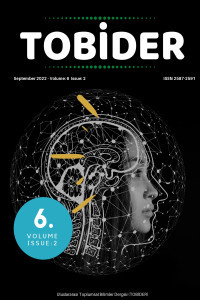MODA AKSESUARLARI OLARAK KİTAPLAR: YANMETİNLER VE ÇEVİRİ
21. yüzyılla beraber medya kültürünün yükselişi, imajların ön plana çıkmasının önünü açmıştır. Bu yükseliş, özellikle daha görünür mecralar üzerinden göze çarpar. Son yıllarda sosyal medya ve moda endüstrisi üzerinden metaların daha görünür kılınmaya çalışıldığı görülür. Edebiyat eserleri de bu bağlamda çeşitli medya araçları ile daha ön plana çıkar. Kültürel tüketim ürünleri olarak ortaya çıkan bu eserler, “gösteri toplumunun” bir parçası olarak çeşitli beğenileri simgeler. Bu yüzyılın toplumsal dinamiklerini anlamak üzere, Guy Debord, Lev Manovish ve Pierre Bourdieu gibi araştırmacıların tanım ve dinamiklere ilişkin araştırmalarından faydalanılır. “Gösteri toplumu”, “estetik toplumu” ve “kültürel sermaye” gibi kavramlar ışığında, kitapların birer moda aksesuarı olarak düşünüldüğü moda dergilerinde yer alan başlıklardan yola çıkılır. Bu bağlamda, kitapların modanın bir parçası haline gelmesinde etkili olan faktörler incelenir. Kitapların tamamlayıcı aksesuarlar olarak düşünülmesi doğrudan kitap kapakları ve tasarımlarıyla ilişkilendirildiğinden, çeviri eserler bağlamında Gerard Genette tarafından ileri sürülen “yanmetin” (“paratext”) kavramından yararlanılır. Kitapların ön ve arka kapakları birer yanmetin sayıldığından, özellikle çeviri kitaplarda kapak tasarımı, eserin edebi niteliğinin yanında oldukça önemli bir yönü kabul edilir. Bu çalışma kapsamında, eserlerin sadece kapaklarına değil, aynı zamanda moda endüstrisi ve sosyal medya üzerinden görünür kılınmalarının kişilerin kitap seçimlerine ilişkin çeşitli zevk ve tercihleri yansıtmasına da odaklanılır. Bu tercihlerin kişilerin kültürel sermayelerini yansıtmasının yanında kitapların satış ve pazarlaması bağlamında etkisi de incelenir.
Anahtar Kelimeler:
moda, çeviri, yanmetin, kültürel tüketim
BOOKS AS FASHION ACCESSORIES: PARATEXTS AND TRANSLATION
The rise of media culture in the 21st century paved the way for images to come to the fore. This rise is especially noticeable through more visible channels. Recently, it has been observed that commodities are rendered more visible through social media and the fashion industry. In this context, literary works come into prominence with various media spectacles. These works, which emerged as cultural consumption products, express various tastes as part of the "society of the spectacle". To understand the social dynamics of this century, the research on definitions and dynamics done by researchers such as Guy Debord, Lev Manovish, and Pierre Bourdieu is utilized. The starting point of the debate is the headlines of fashion magazines in which books are considered fashion accessories in the light of “the society of the spectacle”, “aesthetic society” and “cultural capital” terms. In this context, the factors that are effective in the process of books being a part of fashion are examined. As books as complementary accessories are directly associated with the contents of the book covers and their designs, the notion of "paratext" put forward by Gerard Genette is utilized in the frame of translated literature. Since the front and back pages of the books are considered paratexts, the cover design, especially for translated literature, is considered as a crucial aspect as well as their literary value. The only focus of this study is not on the front covers of the books. It is also scrutinized that the visibility of the translated literature enabled by the fashion industry and social media reflect certain tastes and preferences of the individuals. In addition to the reflection of these preferences on the cultural capital of the customers, the effect ofün the sales and marketing of the books is also examined.
Keywords:
fashion, translation, paratext, cultural consumption.,
___
- Bourdieu, P. 1990. In “Structures, Habitus, Practices”, The Logic of Practice Cambridge: Polity, pp. 52-65.
- Bourdieu, P. 2015. Ayrım: Beğeni Yargısının Toplumsal Eleştirisi. Tr. D. Fırat& G. Berkkurt. Ankara. Heretik Yayıncılık.
- Debord, G. 1967. Society of the Spectacle. Detroit: Black and Red.
- Genette, G. 1987. Seuils. Paris: éditions du Seuil.
- Genette, G. 1997. Paratexts: Thresholds of Interpretation. Tr. Jane E. Lewin. Cambridge: Cambridge University Press.
- Kellner, D. 2005. “Media Culture and The Triumph of the Spectacle”. Fast Capitalism, 1: (1). pp. 58-71.
- Laneri, R. 2019. “Bella and Gigi Hadid make books the hot new accessory of 2019”. New York Post Lifestyle. Online: https://nypost.com/2019/03/19/bella-and-gigi-hadid-make-books-the-hot-new-accessory-of-2019. Access: 15.10.2022
- Macksey, R. 1997. “Foreword.” In Paratexts: Thresholds of Interpretation, Gerard Genette (Tr. Jane E. Lewin), Cambridge: Cambridge University Press. pp. xi–xxiii.
- Manovich, L. 2016. “Designing and Living Instagram Photography: Themes, Feeds, Sequences, Branding, Faces, Bodies”. . Date of Access: 12.10.2022. Online: http://manovich.net/content/04projects/097-designing-and-livinginstagramphotography/instagram_book_part_4.pdf
- Maughan, S. 1998. “Paperback Reissues: Everything Old Is New Again”. Publishers Weekly. pp. 126–29.
- Mutter, J. 2005. “Buying Books by Their Covers”. Publishers Weekly. Volume 252. Issue 11. Online: https://www.publishersweekly.com/pw/print/20050314/31420-buying-books-by-their-covers.html. Access: 01.09.2022
- Satenstein, L. 2019. “Would You Join the Bella and Gigi Hadid Book Club?”. Vogue Fashion. Online: https://www.vogue.com/vogueworld/article/bella-hadid-stephen-king-gigi-hadid-albert-camus-reading. Access: 19.10.2022
- Snow, P. 2019. “Gigi hadid was spotted with a book!”. i-D Culture. Online: https://i-d.vice.com/en/article/nexggg/gigi-hadid-was-spotted-with-a-book. Access: 20.02.2023.
- Webb, J., Schirato, T.,& Danaher, G. 2002. Understanding Bourdieu. Australia: Allen & Unwin. Yampbell, C. 2005. “Judging a Book by Its Cover”, The Lion and the Unicorn, Volume 29, Number 3, pp. 348-372.
- Başlangıç: 2017
- Yayıncı: Sadık Hacı
Sayıdaki Diğer Makaleler
KAHRAMANMARAŞ DEPREMİ ÖZELİNDE TRAVMATİK YAS VE SOSYAL HİZMETİN YAS DANIŞMANLIĞI MÜDAHALESİ
MUSTAFA KUTLU’NUN MÜRİT ADLI ÖYKÜSÜNÜ TAŞRA-KENT ÇATIŞMASI BAĞLAMINDA OKUMAK
BİLİNÇ PROBLEMİNE REVONSUO’NUN YAKLAŞIMI
AMBALAJ MAKİNELERİ İMALAT SEKTÖRÜNDE TEDARİKÇİ SEÇİMİ: BÜTÜNLEŞİK BİR ÇOK KRİTERLİ KARAR MODELİ
YENİDEN ÇEVİRİ EYLEMİNİN DOĞASI VE BU EYLEME ZEMİN HAZIRLAYAN ETKENLER ÜZERİNE BİR DEĞERLENDİRME
SOSYAL İLİŞKİLERİN DIŞSALLIKLAR ÜZERİNDEKİ ETKİSİNE DAİR BİR UYGULAMA
Kasım ULUDAĞ, Adem TÜRKMEN, Hüseyin DAŞTAN
TÜRKİYE’DE CAZ MÜZİĞİNİN İLK KADIN YORUMCUSU: SEVİNÇ TEVS
İlknur AKSOY, Fulya SOYLU BAĞÇECİ
